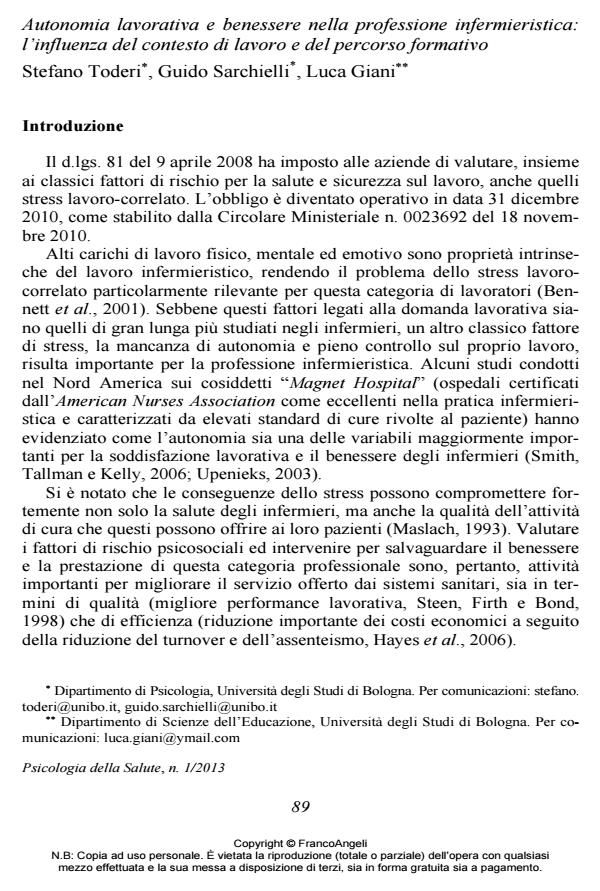Autonomia lavorativa e benessere nella professione infermieristica: l’influenza del contesto di lavoro e del percorso formativo
Titolo Rivista PSICOLOGIA DELLA SALUTE
Autori/Curatori Stefano Toderi, Guido Sarchielli, Luca Giani
Anno di pubblicazione 2013 Fascicolo 2013/1
Lingua Italiano Numero pagine 22 P. 89-110 Dimensione file 465 KB
DOI 10.3280/PDS2013-001005
Il DOI è il codice a barre della proprietà intellettuale: per saperne di più
clicca qui
Qui sotto puoi vedere in anteprima la prima pagina di questo articolo.
Se questo articolo ti interessa, lo puoi acquistare (e scaricare in formato pdf) seguendo le facili indicazioni per acquistare il download credit. Acquista Download Credits per scaricare questo Articolo in formato PDF

FrancoAngeli è membro della Publishers International Linking Association, Inc (PILA)associazione indipendente e non profit per facilitare (attraverso i servizi tecnologici implementati da CrossRef.org) l’accesso degli studiosi ai contenuti digitali nelle pubblicazioni professionali e scientifiche
La mancanza di autonomia è un fattore di rischio particolarmente rilevante per il benessere lavorativo degli infermieri, soprattutto a seguito della riforma che a partire da metà degli anni ’90 ha modificato profondamente il loro profilo professionale. L’obiettivo della ricerca è quello di studiare la relazione tra autonomia e benessere degli infermieri, considerandoli come categoria eterogenea e differenziandoli in base al contesto di svolgimento del lavoro (area dipartimentale) e al tipo di formazione ricevuta (percorso formativo). I dati raccolti attraverso un questionario somministrato a 69 infermieri confermano l’effetto di moderazione di entrambe le variabili. L’autonomia predice il benessere solo nell’area dipartimentale geriatrico-riabilitativa e, in questa, in misura maggiore per gli infermieri con una formazione di tipo professionale. I risultati, che confermano la necessità di considerare gli infermieri come categoria eterogenea, vengono discussi in relazione al diverso significato che l’autonomia può assumere in contesti sanitari diversi e al diverso valore che infermieri con particolari caratteristiche personali le possono dare. Tali differenze sono critiche per pianificare interventi mirati per la riduzione del rischio stress lavoro-correlato.
Parole chiave:Infermieri, processo di professionalizzazione, autonomia lavorativa, benessere affettivo, analisi dei moderatori, stress lavoro-correlato.
- Stress-Preventive Management Competencies, Psychosocial Work Environments, and Affective Well-Being: A Multilevel, Multisource Investigation Stefano Toderi, Cristian Balducci, in International Journal of Environmental Research and Public Health /2018 pp.397
DOI: 10.3390/ijerph15030397 - Reducing psychosocial risks through supervisors' development: A contribution for a brief version of the “Stress Management Competency Indicator Tool” Stefano Toderi, Andrea Gaggia, Cristian Balducci, Guido Sarchielli, in Science of The Total Environment /2015 pp.345
DOI: 10.1016/j.scitotenv.2015.02.082 - Il benessere nei vigili del fuoco volontari: la mindfulness come risorsa psicologica Piergiorgio Argentero, Ilaria Setti, in PSICOLOGIA DELLA SALUTE 2/2015 pp.101
DOI: 10.3280/PDS2015-002006
Stefano Toderi, Guido Sarchielli, Luca Giani, Autonomia lavorativa e benessere nella professione infermieristica: l’influenza del contesto di lavoro e del percorso formativo in "PSICOLOGIA DELLA SALUTE" 1/2013, pp 89-110, DOI: 10.3280/PDS2013-001005